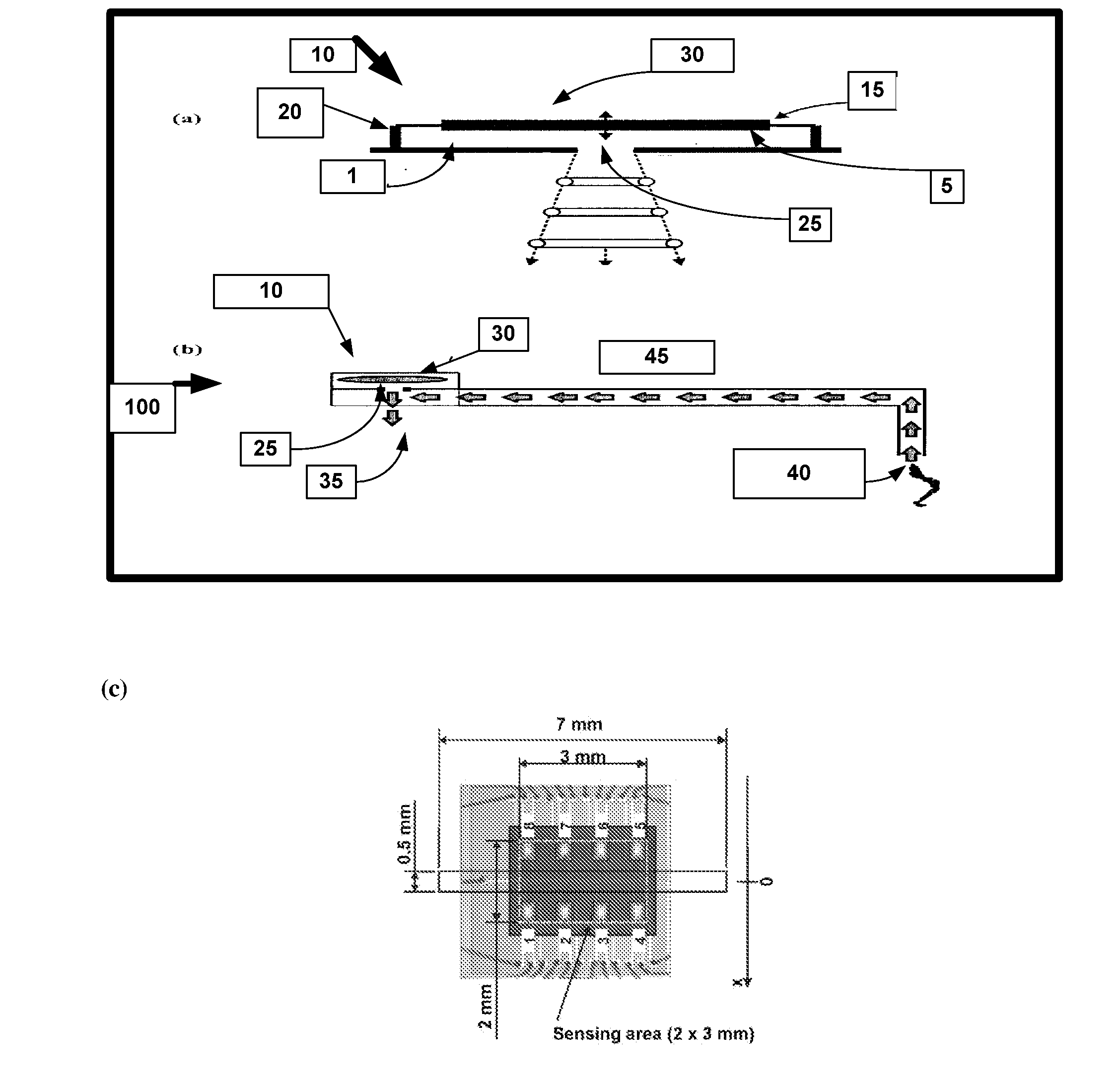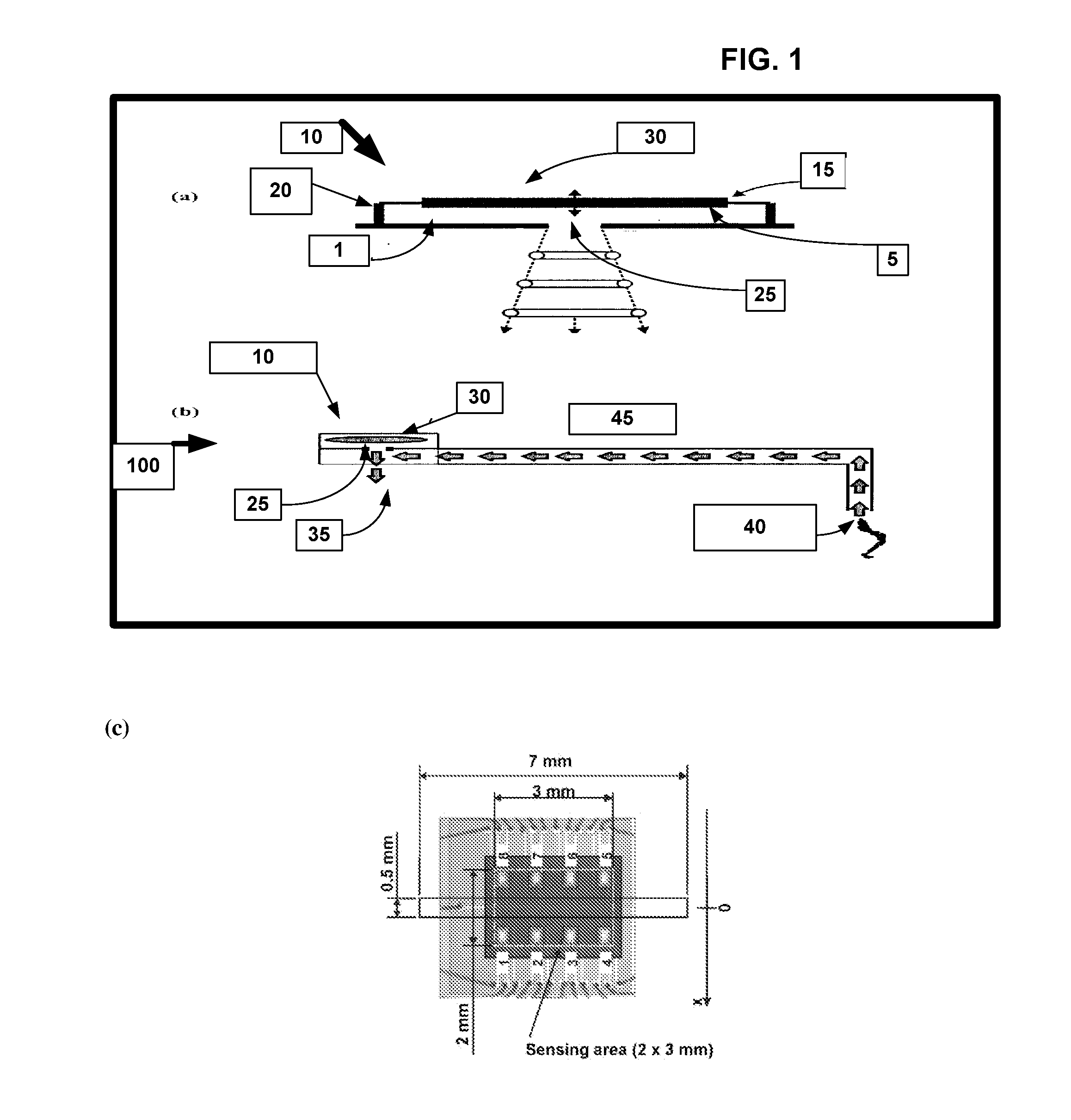Fluidically-assisted sensor systems for fast sensing of chemical and biological substances
a sensor system and chemical and biological technology, applied in the field of chemical and biological sensors, can solve the problems of limited speed, intentional or unintentional contamination of enclosed public places, prior art efforts to use an electronic nose in exemplary applications to monitor ambient air,
- Summary
- Abstract
- Description
- Claims
- Application Information
AI Technical Summary
Benefits of technology
Problems solved by technology
Method used
Image
Examples
example 1
[0053]An exemplary setup of the present invention for fluidic sampling with two different gas sources [(a) vapor above ammonium hydroxide solution and (b) leakage of ammonia gas through a needle valve] is shown schematically in FIG. 4. A three-way solenoid valve (ASCO) is used to switch between the sample gas line and cleaning (flushing) gas that is simply the ambient air which is pumped and transported to the sensor by the jet actuator. The induced flow rate over a range of supplied voltages for jet flows is computed from pressure drop measurements based on laminar Poisseuile flow in the feed tube (L=128.5 cm) using a micromanometer (Dwyer) that can resolve 0.00635 mm-H2O. The variation of the flow rate (computed from pressure drop in the tube) with actuation frequency (F) is shown in FIG. 5 for different actuation voltages (VAC). The data in FIG. 5 show two distinct peaks at the diaphragm's fundamental (nominally 1000 Hz) and second-harmonic resonances. While the flow rate evident...
example 2
[0061]In the following example of an embodiment of the present invention, a fluidic sensor array was integrated into a sensing platform containing eight identical sensing modules separated by micro-structured wells into which a chemically sensitive layer was cast. Each of the modules may be operated in the chemFET (chemically sensitive Field Effect Transistor) or chemiresistor mode. When the sensing platform was operated in the chemFET mode, the change in the gate voltage was monitored at an applied constant drain-source current of about 0.2 mA in the source-follower configuration. FIG. 1(c) shows the exemplary modules with drop-cast films of polyaniline (PANT) doped with (1R)-(−)-10-camphorsulfonic acid (CSA, Aldrich). The stock solution was prepared by dissolving 50 mg of the purified PANI emeraldine base powder (MW 20 000, Aldrich) in 10 mL of formic acid (88%, Fisher Scientific), followed by sonication for 10 minutes and overnight stirring in a closed container, The PANI / CSA sol...
example 3
[0069]FIG. 15 illustrates yet another exemplary embodiment of the present invention in which a fluidic sampling system incorporating a jet actuator according to the present invention is employed to monitor a gas or liquid present within an ambient environment, but not flowing within a conduit. In FIG. 15, an exemplary gas source 95 is releasing a sample gas 40 into a three-dimensional environment 105 defined by dimensions x, y, and z. FIG. 15 is a two-dimensional drawing, and dimension z is not shown in FIG. 15. As shown in FIG. 15, a fluidic sensing system with an integral jet actuator 100 according to the present invention comprises a jet activator 10 with a jet actuator orifice 25 that serves as both an inlet and outlet for said jet actuator 10 and a sensor 35, enclosed by a sensor enclosure 120 with a sensor inlet 125 (oriented towards the jet actuator orifice 25) and an exhaust outlet 130. In the embodiment shown in FIG. 15, an amount of ambient gas is drawn into the jet actuat...
PUM
| Property | Measurement | Unit |
|---|---|---|
| diameters | aaaaa | aaaaa |
| speeds | aaaaa | aaaaa |
| speeds | aaaaa | aaaaa |
Abstract
Description
Claims
Application Information
 Login to View More
Login to View More - R&D
- Intellectual Property
- Life Sciences
- Materials
- Tech Scout
- Unparalleled Data Quality
- Higher Quality Content
- 60% Fewer Hallucinations
Browse by: Latest US Patents, China's latest patents, Technical Efficacy Thesaurus, Application Domain, Technology Topic, Popular Technical Reports.
© 2025 PatSnap. All rights reserved.Legal|Privacy policy|Modern Slavery Act Transparency Statement|Sitemap|About US| Contact US: help@patsnap.com



